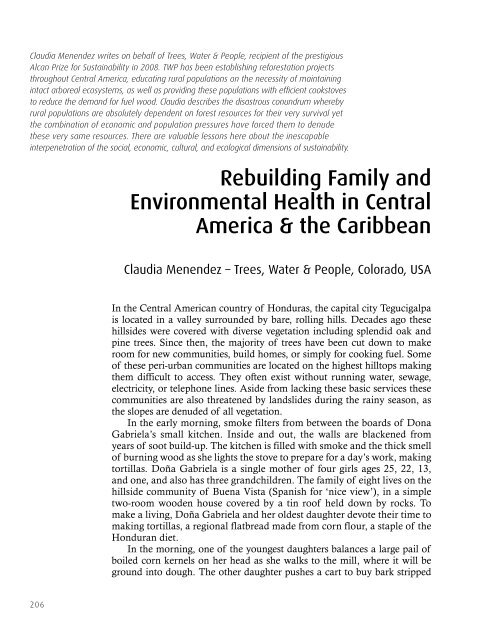Designing Ecological Habitats - Gaia Education
Designing Ecological Habitats - Gaia Education
Designing Ecological Habitats - Gaia Education
You also want an ePaper? Increase the reach of your titles
YUMPU automatically turns print PDFs into web optimized ePapers that Google loves.
Claudia Menendez writes on behalf of Trees, Water & People, recipient of the prestigious<br />
Alcan Prize for Sustainability in 2008. TWP has been establishing reforestation projects<br />
throughout Central America, educating rural populations on the necessity of maintaining<br />
intact arboreal ecosystems, as well as providing these populations with efficient cookstoves<br />
to reduce the demand for fuel wood. Claudia describes the disastrous conundrum whereby<br />
rural populations are absolutely dependent on forest resources for their very survival yet<br />
the combination of economic and population pressures have forced them to denude<br />
these very same resources. There are valuable lessons here about the inescapable<br />
interpenetration of the social, economic, cultural, and ecological dimensions of sustainability.<br />
206<br />
Rebuilding Family and<br />
Environmental Health in Central<br />
America & the Caribbean<br />
Claudia Menendez – Trees, Water & People, Colorado, USA<br />
In the Central American country of Honduras, the capital city Tegucigalpa<br />
is located in a valley surrounded by bare, rolling hills. Decades ago these<br />
hillsides were covered with diverse vegetation including splendid oak and<br />
pine trees. Since then, the majority of trees have been cut down to make<br />
room for new communities, build homes, or simply for cooking fuel. Some<br />
of these peri-urban communities are located on the highest hilltops making<br />
them difficult to access. They often exist without running water, sewage,<br />
electricity, or telephone lines. Aside from lacking these basic services these<br />
communities are also threatened by landslides during the rainy season, as<br />
the slopes are denuded of all vegetation.<br />
In the early morning, smoke filters from between the boards of Dona<br />
Gabriela’s small kitchen. Inside and out, the walls are blackened from<br />
years of soot build-up. The kitchen is filled with smoke and the thick smell<br />
of burning wood as she lights the stove to prepare for a day’s work, making<br />
tortillas. Doña Gabriela is a single mother of four girls ages 25, 22, 13,<br />
and one, and also has three grandchildren. The family of eight lives on the<br />
hillside community of Buena Vista (Spanish for ‘nice view’), in a simple<br />
two-room wooden house covered by a tin roof held down by rocks. To<br />
make a living, Doña Gabriela and her oldest daughter devote their time to<br />
making tortillas, a regional flatbread made from corn flour, a staple of the<br />
Honduran diet.<br />
In the morning, one of the youngest daughters balances a large pail of<br />
boiled corn kernels on her head as she walks to the mill, where it will be<br />
ground into dough. The other daughter pushes a cart to buy bark stripped







